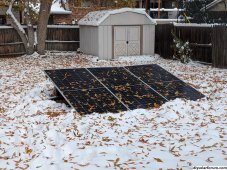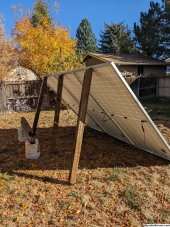Try show lowI think the problem is that most members here use PV Watts and I don't think it is accurate.
I just inputted Phoenix in JRC again, used fixed grid tie at 35 degrees and result is different than yours. What are you using for System Loss % ?
I also ran tracking and checked Optimize. Numbers are still different.
So either it isn't Phoenix or some other input is different.
You are using an out of date browser. It may not display this or other websites correctly.
You should upgrade or use an alternative browser.
You should upgrade or use an alternative browser.
I don't like adjustable racking
- Thread starter SignatureSolarJames
- Start date
Zwy
Emperor Of Solar
Tried it using 10Kw of PV and things are still different.Try show low
Nice area, I'll be coming thru from TX to Quartzsite/Yuma in January. Looks cold where you are with snow.
Kenny_
Solar Addict
I wonder what it is we are doing differently. I put 8.8 vs 10k but I don’t know what you’re seeing differently for results eitherTried it using 10Kw of PV and things are still different.
Nice area, I'll be coming thru from TX to Quartzsite/Yuma in January. Looks cold where you are with snow.
I left the default settings for system loss and other factors
Yes, but that's just because all the leaves fall off themI have no fancy adjustments on my panels/angles/etc. (need to do an actual install of some type some time soon) but when I raise them manually/precariously more off the ground I get something like a 20-30 % increase..
View attachment 177913
View attachment 177914
Kenny_
Solar Addict
timselectric
If I can do it, you can do it.
- Joined
- Feb 5, 2022
- Messages
- 19,796
I didn't like seeing red on the graph.
So, I disconnected the grid.
Problem solved. lol
So, I disconnected the grid.
Problem solved. lol
Kenny_
Solar Addict
Yep I had that huge grid spike on 11/9 cause the two days before that were virtually no sun...overcast snow...etc... battery hit bottom, went to grid charging and bypass til 100 % SOC.
ksmithaz1
Solar / EV Junkie
May head up there for thanksgiving just to get away. Really nice library there with an EV charging station at the City Center. Great place to stop and charge, you can leave the car, go inside with the laptop, use the Wifi, there are a few coffee shops close by. Not a great Solar day but 4 nice charging stations at the edge of the parking lot, mostly visible from the library window.Try show low

ksmithaz1
Solar / EV Junkie
I have no fancy adjustments on my panels/angles/etc. (need to do an actual install of some type some time soon) but when I raise them manually/precariously more off the ground I get something like a 20-30 % increase..
I can believe it, your winter optimal is closer to 60 degrees. I think the production curve really starts to drop at about 30 degrees from optimal. I'd bet you wouldn't notice that much difference between 40 and 60, but DUDE! C'mon go to Home depot and pick up a couple of 2x4's and build a simple braced lean-to / triangle. I mean I know you CAN use an old rotted fence post under each panel but sheesh! $50 of lumber I stretched a pair of these: https://www.amazon.com/gp/product/B0831DDS9W/ref=ppx_od_dt_b_asin_title_s00?ie=UTF8&psc=1 with some angle iron. I did have to buy some longer hex drive bolts, to get the mounts to work. cheesy but funtional
Kenny_
Solar Addict
Ha! I know, I know....that's maybe what I'm thinking just to get by til I determine where to go more permanently. ????I can believe it, your winter optimal is closer to 60 degrees. I think the production curve really starts to drop at about 30 degrees from optimal. I'd bet you wouldn't notice that much difference between 40 and 60, but DUDE! C'mon go to Home depot and pick up a couple of 2x4's and build a simple braced lean-to / triangle. I mean I know you CAN use an old rotted fence post under each panel but sheesh! $50 of lumber I stretched a pair of these: https://www.amazon.com/gp/product/B0831DDS9W/ref=ppx_od_dt_b_asin_title_s00?ie=UTF8&psc=1 with some angle iron. I did have to buy some longer hex drive bolts, to get the mounts to work. cheesy but funtional
ksmithaz1
Solar / EV Junkie
Panels are ususally 40-45" wide I considered using a dado to groove some 2x4's, either a 12' or 2 6's with a brace in the middle, create an upside down picture frame, just lay the panels three across in the groove. Two simple L supports in the back 1/2 cut the riser side long, drill a couple of holes to put a pin for height adjustment. Price of lumber came down a little, I might revisit this one myself. Just tack the panels down at the top with a screw. The other thought was a 2x4 and a 2x2 or 1x2 for the frame. Set the mess on a couple of leveled cinder block, call it temporarily permanent!
It's dry enough here it would last 20 years without even painting it. I think you are where I'm at. I know I want to put it up, but I'm trying to figure out where I can put it to maximize output. I the summer the sun rises in the Northeast and sets to the Northwest, in the Winter its Southeast ad Soutwest, plus I have a 6-8ft block fence around the property. I think getting everything up about 3ft off the ground will be pretty big, and then face maybe south-southwest 30 degrees, from the northeast edge of the property.
Once you sink posts and/or cement you commit!
It's dry enough here it would last 20 years without even painting it. I think you are where I'm at. I know I want to put it up, but I'm trying to figure out where I can put it to maximize output. I the summer the sun rises in the Northeast and sets to the Northwest, in the Winter its Southeast ad Soutwest, plus I have a 6-8ft block fence around the property. I think getting everything up about 3ft off the ground will be pretty big, and then face maybe south-southwest 30 degrees, from the northeast edge of the property.
Once you sink posts and/or cement you commit!





